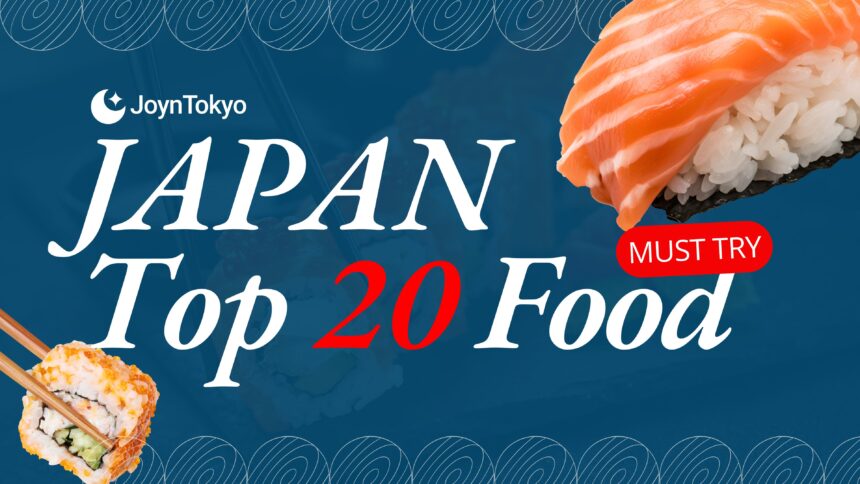Japanese cuisine, known as washoku, earned a place on UNESCO’s Intangible Cultural Heritage list in 2013, and every meal balances regional and seasonal ingredients with meticulous presentation that harmonizes taste, sight, and aroma. From bustling city markets to countryside family tables, traditional flavors mingle with modern creativity to craft unforgettable food adventures, and the dishes below capture this everyday spectrum while noting options for travelers with specific dietary needs.
Japanese Staple Dishes
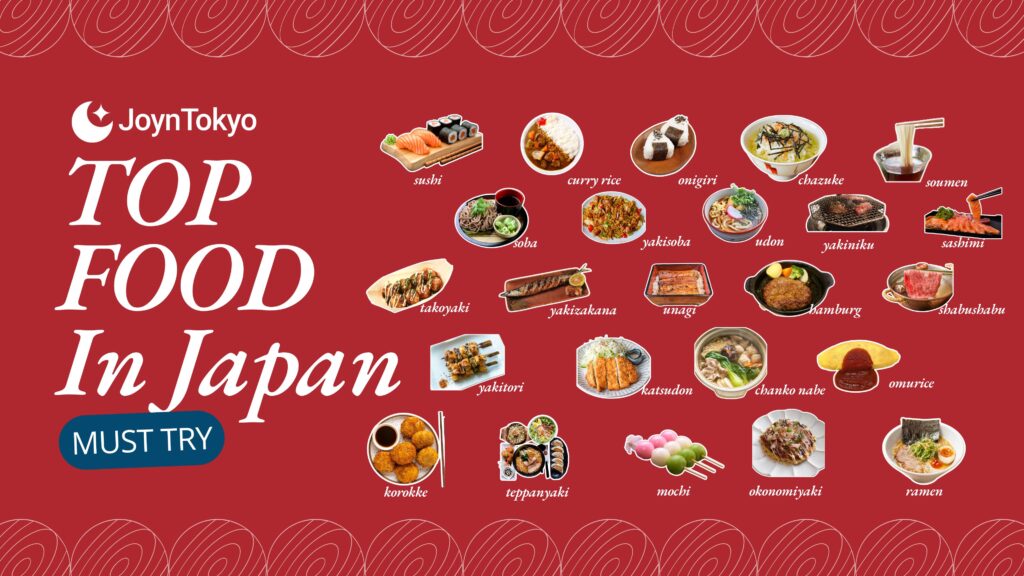
Every home keeps rice, soy sauce, miso, and dried seaweed on hand, so many beloved staples are built around these pantry foundations. They are filling, affordable, and often form the centerpiece of a weekday dinner.
Sushi
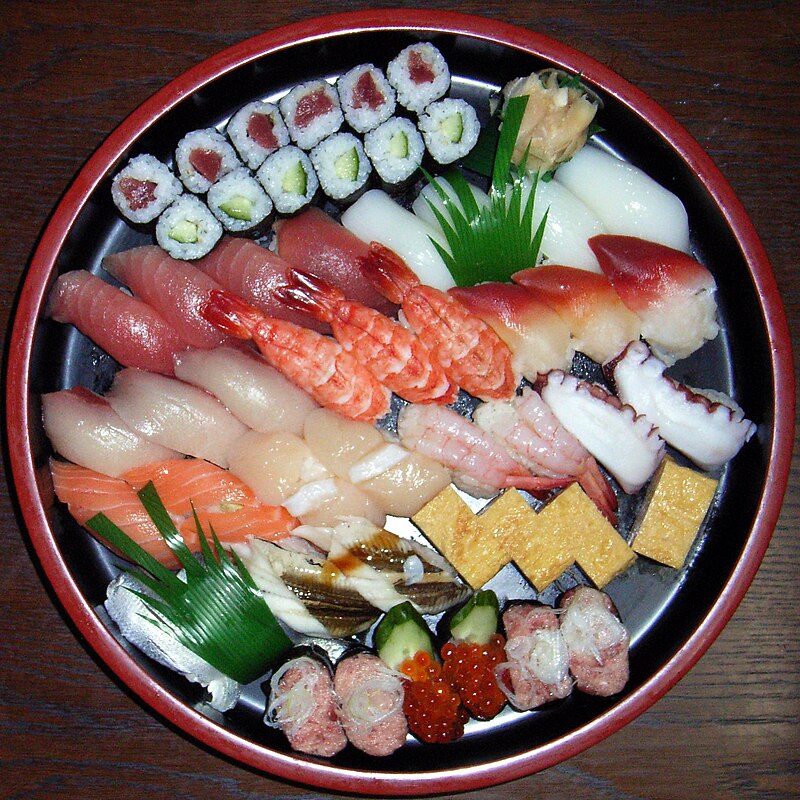
Sushi pairs subtly seasoned rice with toppings that range from buttery tuna to sweet omelette. In casual conveyor belt shops you simply lift the color coded plates you fancy, while at a quiet counter the chef shapes each morsel in front of you like edible art. Choices include hand pressed nigiri, seaweed wrapped rolls, and elaborate pressed sushi from Kansai. The delicate balance between rice temperature, wasabi heat, and soy saltiness rewards slow appreciation.
- Region: Edo, present day Tokyo, with regional toppings nationwide
- Dietary notes: Contains raw seafood and soy sauce with gluten, vegetarian options such as cucumber or pickled radish rolls are possible, gluten free if tamari is used instead of regular soy sauce
- Key ingredients: Short grain rice, rice vinegar, sugar, salt, nori, fresh fish such as tuna or salmon, wasabi, soy sauce
- Usual cost: ¥1,000–¥3,000 at kaiten sushi, ¥10,000 and up for omakase
Curry Rice
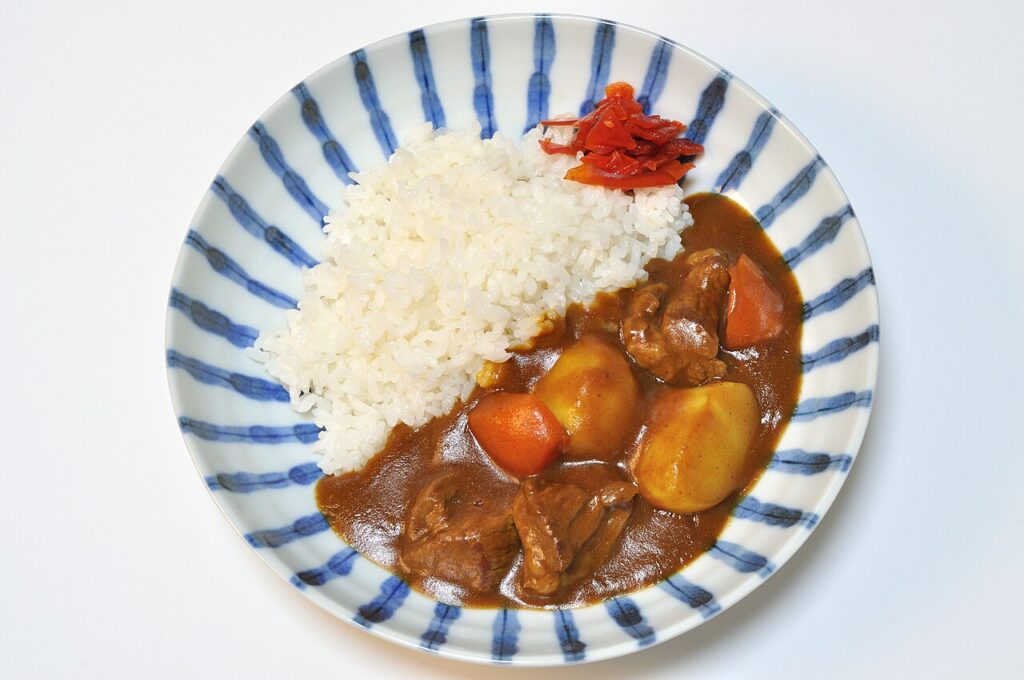
Japanese curry coats rice in a thick mildly spiced gravy that feels like a culinary hug. The dish sailed in with the Imperial Navy in the nineteenth century, then home cooks sweetened the spice and added potatoes, carrots, and onions. Every family swears by a favorite roux brand, and restaurants compete with pork cutlet toppings or cheese stuffed variations. The aroma drifting from a lunch counter instantly signals comfort food to locals.
- Region: Yokosuka in Kanagawa is considered the birthplace of navy style curry, now enjoyed throughout the country
- Dietary notes: Contains wheat in the roux, usually includes meat, vegetarian versions that use vegetable stock and gluten free roux are increasingly available
- Key ingredients: Japanese curry roux blocks, rice, onion, carrot, potato, meat such as chicken or pork, fukujinzuke pickles
- Usual cost: ¥700–¥1,500
Onigiri
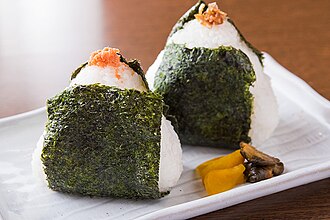
Onigiri compresses warm rice around savory centers then wraps everything in crisp seaweed for a tidy pocket meal. Fillings range from briny salted salmon to tangy ume plum, and convenience stores restock them several times a day so they stay fresh. Hikers, students, and office workers all rely on these triangles for reliable energy. A gentle sprinkling of salt on the rice surface helps preserve flavor and keeps the grains from sticking to hands.
- Region: Nationwide food history mentions onigiri as far back as the Nara period, regional fillings vary
- Dietary notes: Naturally gluten free, filling determines suitability for vegetarians or vegans, look for kombu or umeboshi fillings for plant based eating
- Key ingredients: Cooked Japanese rice, sea salt, nori, fillings such as salted salmon, pickled plum, kombu, or tuna mayonnaise
- Usual cost: ¥120–¥350 each
Tempura
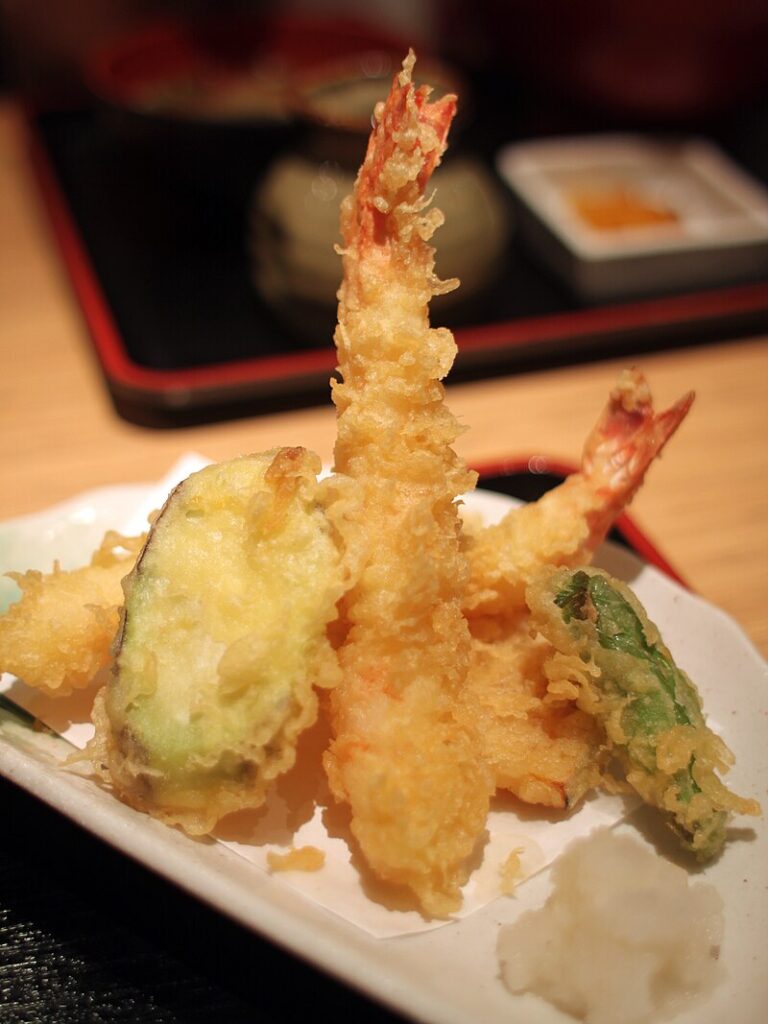
Tempura turns seafood and vegetables into airy golden clouds by using ice cold batter and lightning fast frying. Portuguese missionaries introduced the method centuries ago, yet Japanese cooks perfected a whisper thin coating that highlights rather than hides flavor. Diners dip each piece in light tentsuyu broth or sprinkle just a hint of salt to enjoy the contrast of crisp shell and juicy interior. A mixed platter often features shrimp, shiitake mushroom, and sweet potato so everyone finds a favorite.
- Region: First popular in Edo after arriving through Portuguese influence in Nagasaki, today each prefecture offers local catches and produce
- Dietary notes: Batter contains wheat and egg, pescatarian friendly when using seafood, vegetarian if only vegetables are fried
- Key ingredients: Shrimp or seasonal vegetables, cake flour, egg, ice water, frying oil, tentsuyu dipping sauce made with dashi, soy sauce, mirin, grated daikon
- Usual cost: ¥1,200–¥3,500 for a set meal
Ochazuke
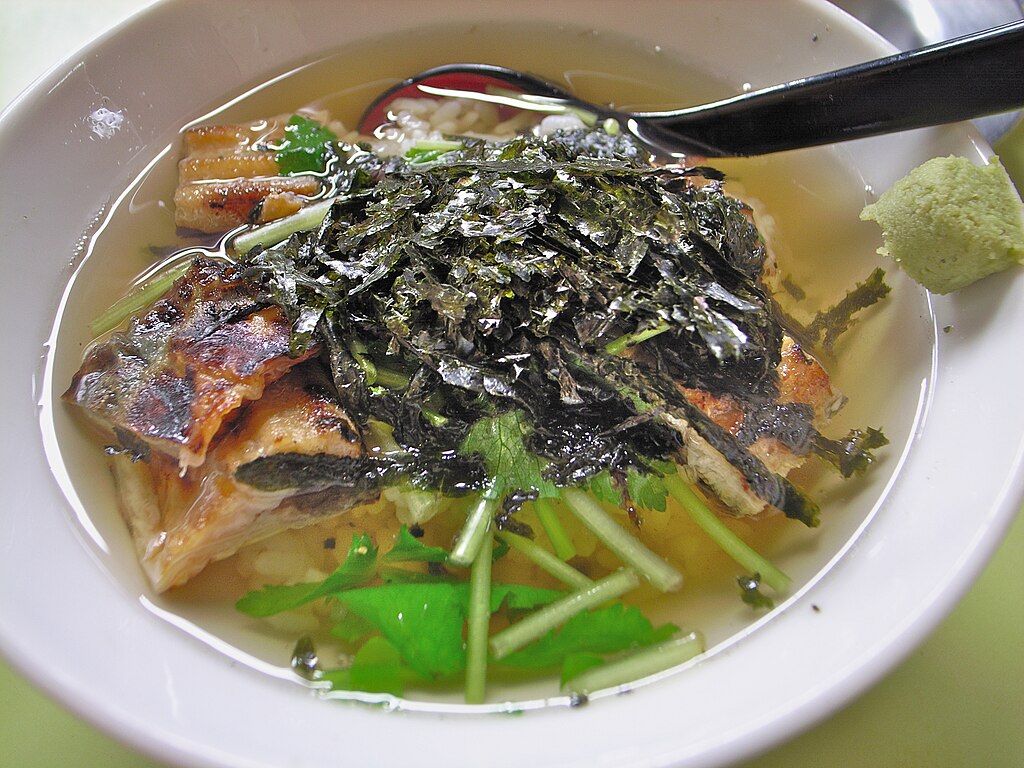
Ochazuke rescues leftover rice by bathing it in hot green tea or delicate dashi, creating a soothing end of day soup. Toppings such as grilled salmon flakes, shredded nori, or pickled mustard greens add texture and mild salt. Many izakaya finish multi course dinners with a small bowl so guests depart with warm satisfied stomachs. At home it doubles as a midnight snack that comes together in minutes.
- Region: Kyoto tea culture made ochazuke popular, though it is common in homes nationwide
- Dietary notes: Usually gluten free, can be vegetarian when made with green tea and vegetable toppings, dashi made with fish will make it non vegetarian
- Key ingredients: Cooked rice, sencha or genmaicha tea, dashi, toppings such as grilled salmon, nori, sesame seeds, pickled vegetables
- Usual cost: ¥500–¥1,200
Takoyaki
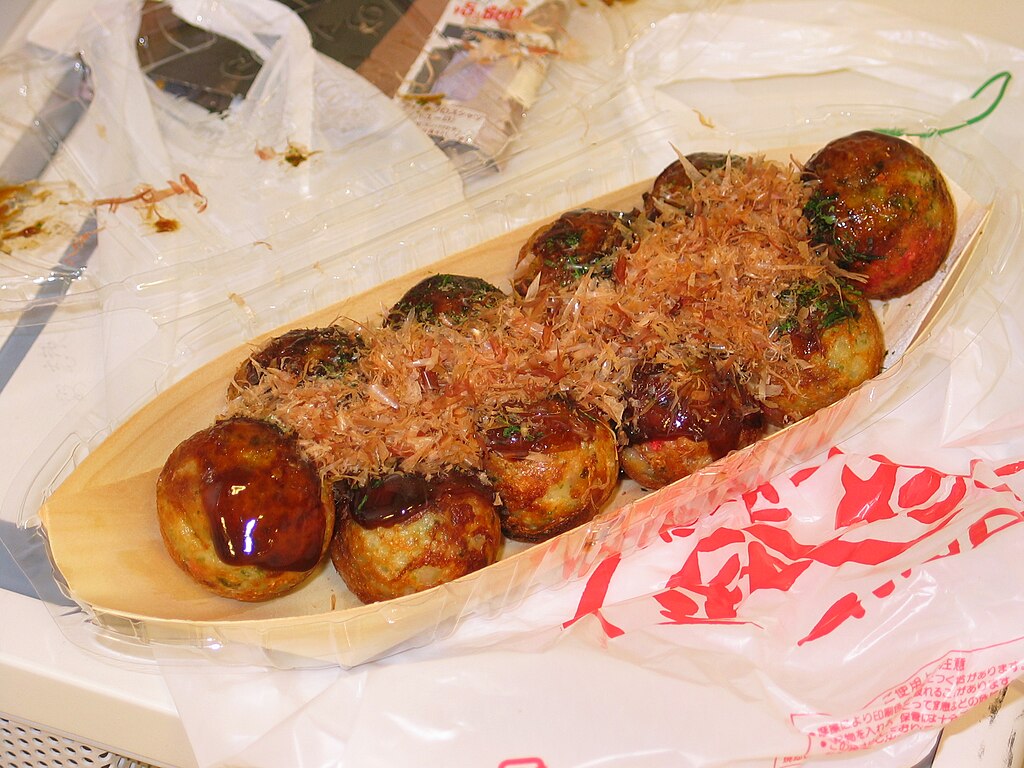
Takoyaki are golden, crispy-on-the-outside, molten-on-the-inside octopus balls served hot from street vendor griddles. Made from a wheat-based batter and filled with diced octopus, green onions, and pickled ginger, they’re brushed with takoyaki sauce and a generous swirl of mayonnaise. Bonito flakes dance atop each ball as the heat rises, creating a visually delightful snack. Popular at festivals and markets, takoyaki deliver both crunch and gooey indulgence in each bite.
- Region: Osaka, especially in Dotonbori district
- Dietary notes: Contains wheat, egg, and seafood; not vegetarian or gluten free
- Key ingredients: Flour, dashi, eggs, octopus, pickled ginger, green onion, takoyaki sauce, mayonnaise, bonito flakes, aonori
- Usual cost: ¥500–¥800 for 6–8 pieces
Japanese Noodle Dishes
Noodles showcase wheat and buckwheat craft, distinct regional broths, and the treasured slurping culture that signals both enjoyment and freshness.
Ramen
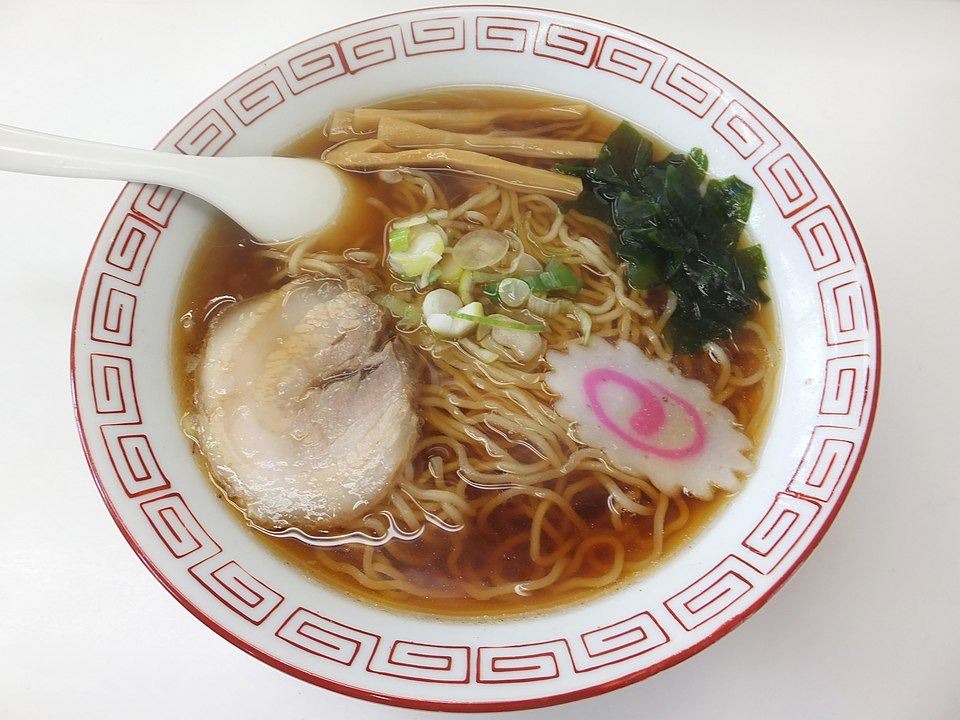
Ramen unites springy wheat noodles with broths that tell regional stories, whether creamy pork from Fukuoka or miso rich soup from snowy Sapporo. Each bowl balances noodles, tare seasoning, and aromatic oils to create depth far greater than the sum of parts. Toppings like flame seared pork, nori squares, and ajitama eggs turn the dish into a build your own adventure. Late night slurping at a steamy counter is almost a national pastime.
- Region: Hakata, Tokyo, Sapporo, and Kyoto each champion distinct broths and toppings
- Dietary notes: Contains wheat in noodles and often pork or chicken in broth, gluten free or vegetarian broths are rare but specialty shops exist
- Key ingredients: Ramen noodles, broth base of pork bones or chicken carcasses, soy sauce or miso, kombu, dried sardines, toppings such as chashu pork, soft boiled egg, green onion
- Usual cost: ¥800–¥1,400
Soba

Soba offers an earthy buckwheat aroma that stands out against crisp tempura or subtle dipping sauce. In summer the noodles arrive chilled on a bamboo tray with wasabi ready for mixing, while winter brings bowls of steaming duck broth that warm cold hands. Skilled artisans grind buckwheat daily and hand cut strands with rhythmic knife strokes. The simplicity invites diners to focus on texture and the faint sweetness of the grain.
- Region: Nagano, known as Shinshu, is famous for high quality buckwheat, also popular in the mountains of Yamagata
- Dietary notes: Many soba noodles include some wheat for elasticity, pure buckwheat versions can be gluten free, dipping sauce contains soy so contains gluten unless tamari is used
- Key ingredients: Buckwheat noodles, mentsuyu dipping sauce made with dashi and soy sauce, sliced scallion, wasabi, sometimes tempura on the side
- Usual cost: ¥700–¥1,500
Udon
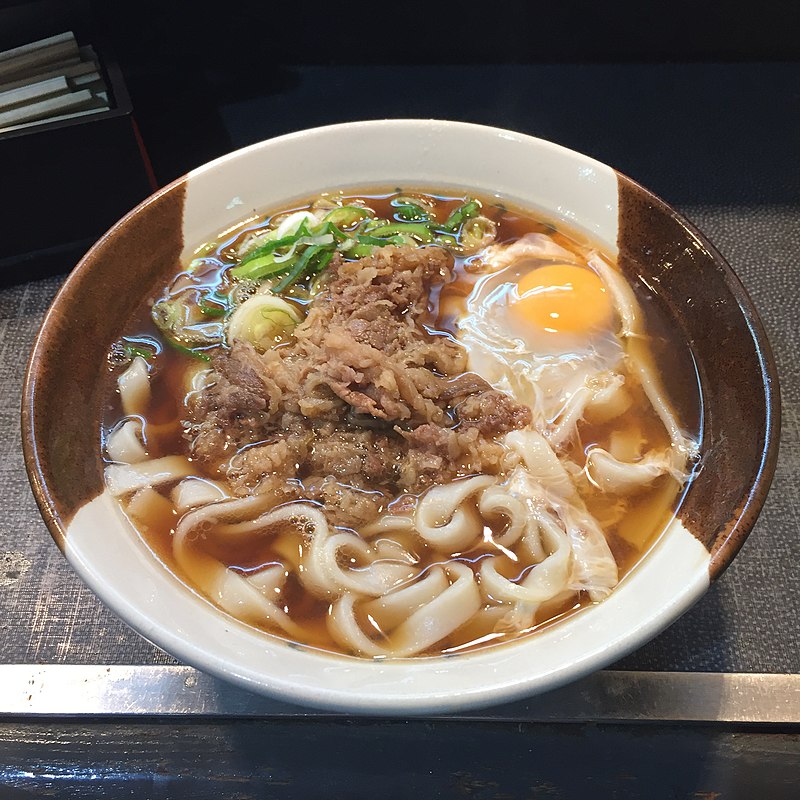
Udon charms with thick chewy strands that soak up gentle soy broth or bold curry sauce. Sanuki style noodles boast a firm bite prized by purists, whereas Kansai shops favor a lighter soup that lets wheat sweetness shine. Watching dough repeatedly folded and pressed with a heavy wooden bar shows the labor behind that satisfying texture. Optional toppings range from crispy fried tofu to prawn tempura, ensuring options for every appetite.
- Region: Kagawa Prefecture, formerly Sanuki, is the spiritual home of udon, Kitsune style in Osaka features sweet fried tofu
- Dietary notes: Contains wheat, various toppings determine if dish is vegetarian, vegan broth options are limited
- Key ingredients: Udon noodles, dashi soy broth, mirin, toppings such as aburaage fried tofu, tempura shrimp, green onion
- Usual cost: ¥600–¥1,200
Soumen
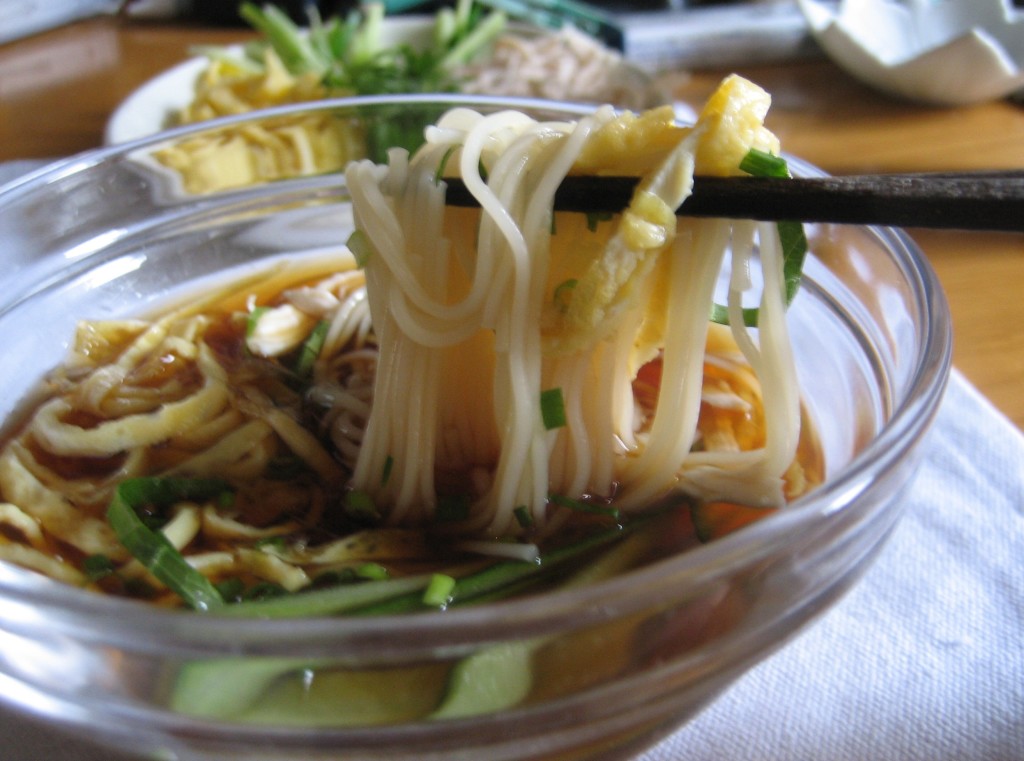
Soumen presents impossibly thin noodles that chill in ice water to combat humid summers. The ritual of catching strands as they glide along a bamboo flume delights children and adults alike. Eaten plain then dipped in cool soy sauce with ginger, the dish refreshes without weighing diners down. At home families prepare a communal bowl and compete playfully for the next passing cluster.
- Region: Miwa in Nara Prefecture has produced soumen for centuries
- Dietary notes: Contains wheat, dipping sauce includes soy with gluten, vegetarian friendly when served with vegetable garnishes
- Key ingredients: Soumen noodles, ice water, mentsuyu dipping sauce, grated ginger, shredded shiso leaves, sesame seeds
- Usual cost: ¥600–¥1,200
Japanese Seafood Delicacies
Japan is an island nation blessed with both warm and cold currents, so fresh catch arrives daily to markets and restaurants. Whether raw, grilled, or glazed, seafood dishes highlight natural umami.
Sashimi

Sashimi showcases the sea at its purest, with glistening slices arranged like jewel toned fans on chilled plates. Chefs judge fish by clarity of flesh and clean ocean scent before wielding a sashimi knife in smooth confident strokes. A dab of freshly grated wasabi brightens each bite without overpowering subtle sweetness. The experience encourages mindfulness and respect for pristine ingredients.
- Region: Coastal areas supply regional specialities, for example tai from Ehime and maguro from Shizuoka
- Dietary notes: Naturally gluten free except for soy sauce, not suitable for vegetarians, celiacs can use gluten free soy
- Key ingredients: Assorted fresh fish fillets, soy sauce, real wasabi or horseradish, shiso leaves, shredded daikon garnish
- Usual cost: ¥1,200–¥4,000 per plate
Yakizakana
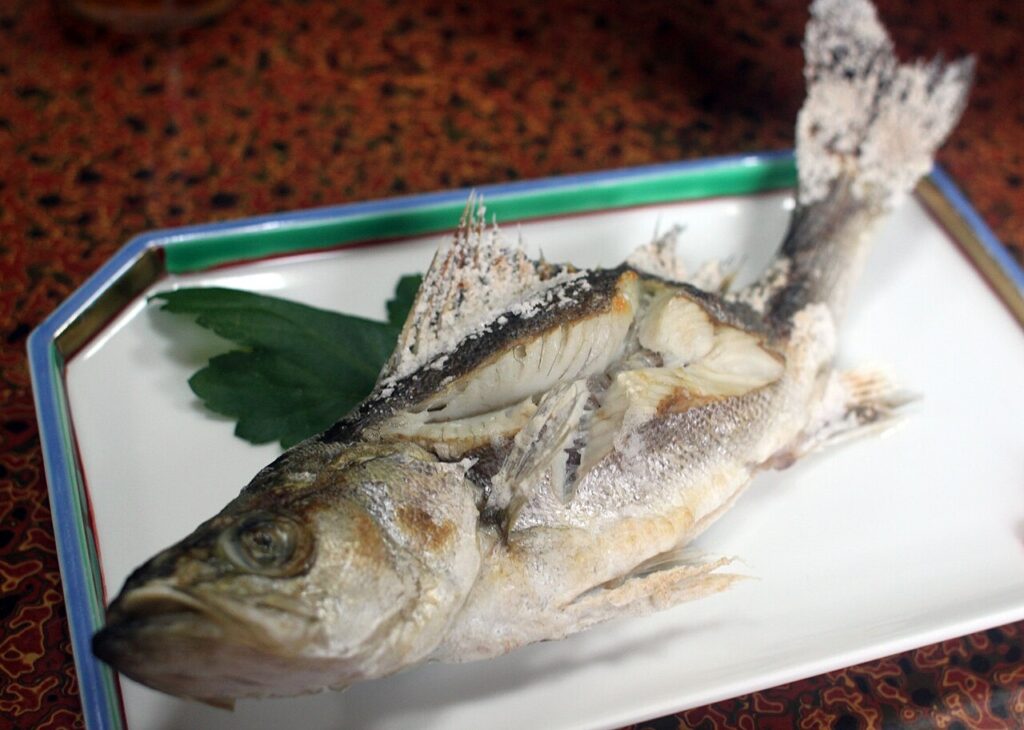
Yakizakana delivers smoky aroma and crisp skin by grilling whole fish over open flame, a breakfast staple in many ryokan inns. Light salting draws out moisture so the flesh flakes apart while retaining natural oils. Diners use chopsticks to lift tender meat away from bones, then balance richness with tangy grated daikon. The simplicity celebrates seasonal catch without heavy seasoning.
- Region: Common along all coasts, Hokkaido salmon and Niigata mackerel are popular regional catches
- Dietary notes: Naturally gluten free, not vegetarian, minimal seasoning makes it suitable for many allergies
- Key ingredients: Whole fish, sea salt, lemon or sudachi citrus wedges, grated daikon radish
- Usual cost: ¥900–¥1,800 for a set meal
Unagi
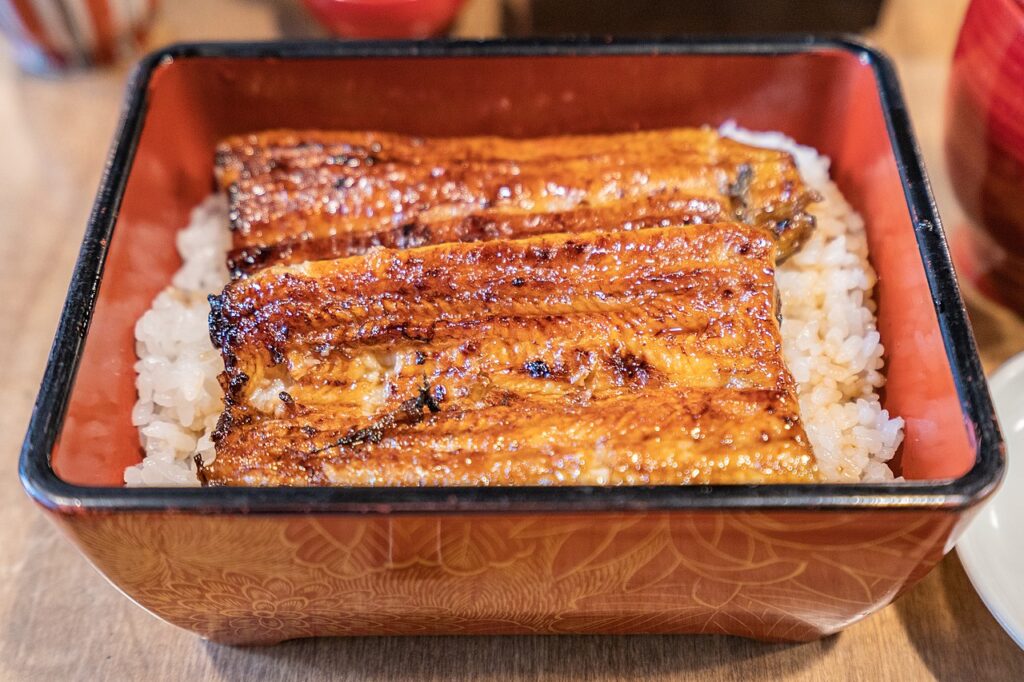
Unagi, or freshwater eel, is butter soft after slow grilling and repeated basting with sweet soy glaze. Many Japanese believe the high calorie dish restores energy during humid midsummer days, leading to queues on the Day of the Ox. The glossy fillet is served over steamed rice so the sauce seeps into every grain. A sprinkle of citrusy sansho pepper cuts through the richness for perfect balance.
- Region: Lake Hamana in Shizuoka is historically famed for eel farming
- Dietary notes: Contains soy and wheat in the sauce, not suitable for vegetarians, gluten free versions require tamari based sauce
- Key ingredients: Eel fillet, kabayaki sauce of soy, mirin, sugar, sake, steamed rice, sansho pepper
- Usual cost: ¥2 500–¥5 000 for unadon bowl
Japanese Meat Classics
Although Japan is renowned for seafood, meat preparations developed unique table top grills, hot pots, and crispy coatings that delight carnivores and social eaters alike.
Yakitori
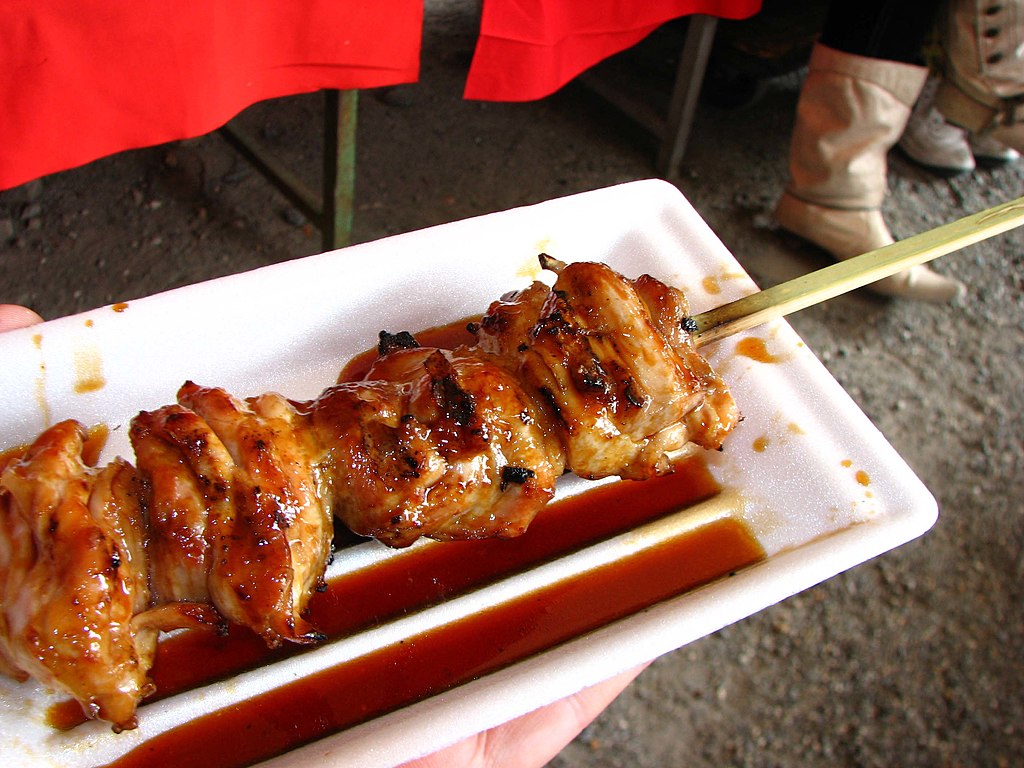
Yakitori lines smoky alleyways with glowing charcoal pits and the intoxicating scent of caramelized soy. Skewers showcase the whole bird, from juicy thigh to crunchy cartilage, and regulars order by shorthand codes understood only by the grill master. A quick dip in sweet soy glaze lends sheen while a salt only version highlights natural flavor. Beer or highball completes the relaxed evening ritual.
- Region: Tokyo alleyways such as Omoide Yokocho are iconic, Sendai is known for miso glazed skewers
- Dietary notes: Not vegetarian, gluten free if only salt is used for seasoning, tare sauce contains soy and wheat
- Key ingredients: Chicken thigh, breast, liver, leek segments, bamboo skewers, tare sauce of soy, mirin, sake, sugar, or simple sea salt
- Usual cost: ¥150–¥300 per skewer, typical bill ¥1 000–¥2 500
Tonkatsu

Tonkatsu elevates a humble cutlet by packing panko crumbs all around so the exterior shatters like a shell while the pork stays moist inside. Diners drizzle tangy fruit sauce or dab sharp mustard before alternating bites with crunchy cabbage. Some restaurants grind sesame seeds at the table to release nutty aroma into the sauce. Leftovers often transform into the next day’s curry topping.
- Region: First served at Renga Tei in Ginza Tokyo in the eighteen nineties
- Dietary notes: Contains wheat and egg, not suitable for vegetarians, gluten free flour and panko substitutes exist at some specialty shops
- Key ingredients: Pork cutlet, salt, pepper, flour, beaten egg, panko breadcrumbs, oil for frying, tonkatsu sauce, shredded cabbage
- Usual cost: ¥1,000–¥2,000
Okonomiyaki
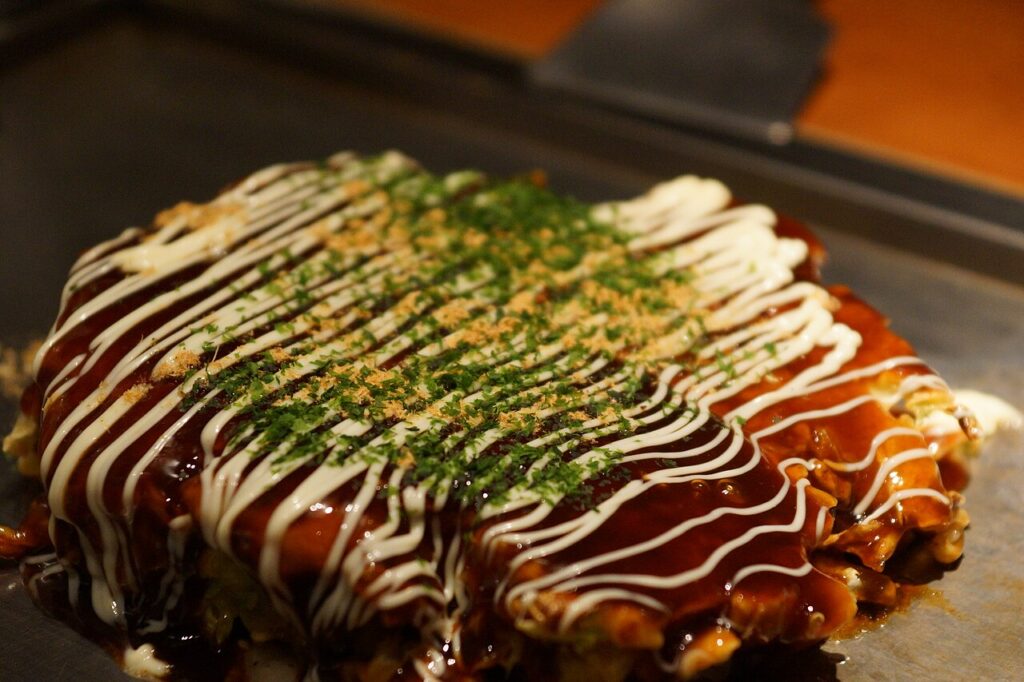
Okonomiyaki is a hearty, savory pancake packed with cabbage and whatever else your taste buds desire. The name literally means “as you like it grilled,” and toppings range from pork belly to squid or even cheese. Diners often cook it themselves on hot griddles at their tables, then drizzle it with sauce, mayo, bonito flakes, and seaweed powder. Regional variations include Osaka’s mixed style and Hiroshima’s layered version with noodles.
- Region: Osaka and Hiroshima are the primary style origins
- Dietary notes: Contains wheat and egg, often includes meat or seafood, vegetarian options available with only vegetables and cheese
- Key ingredients: Flour, egg, cabbage, dashi, pork or seafood, okonomiyaki sauce, mayonnaise, aonori, bonito flakes
- Usual cost: ¥800–¥1,500
Chanko Nabe
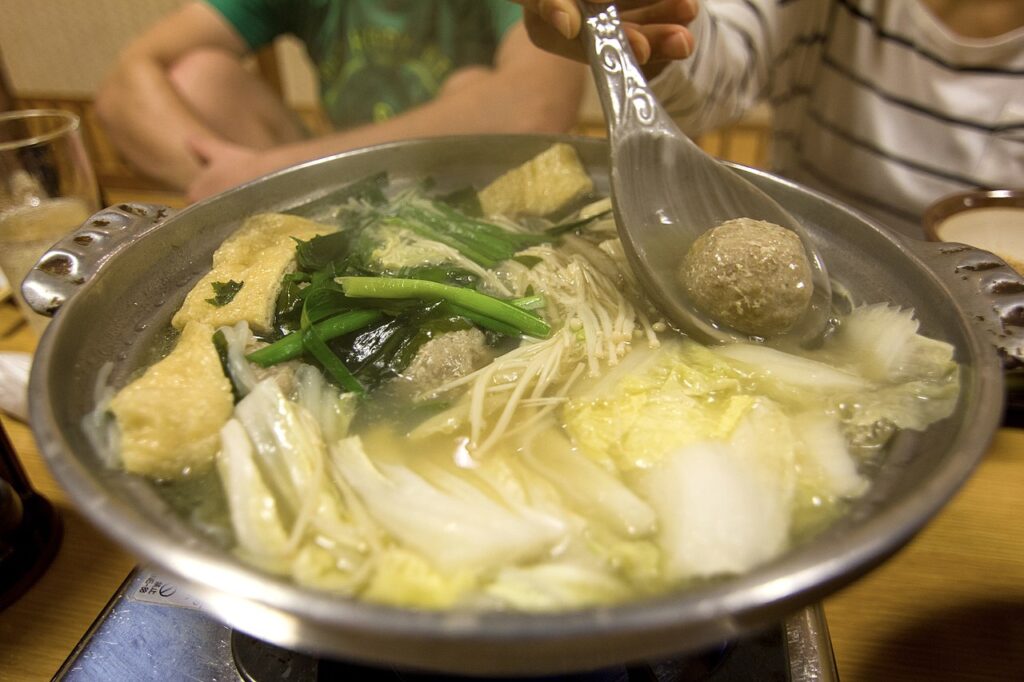
Chanko nabe is the filling stew famously eaten by sumo wrestlers to bulk up, but it’s beloved by all for its satisfying warmth. A huge pot of broth bubbles with meatballs, chicken, tofu, and vegetables, served communally for dipping and sharing. The meal is balanced and nutritious, despite its reputation, and is usually eaten with rice or noodles. Many restaurants specializing in chanko are owned by retired sumo wrestlers.
- Region: Ryogoku in Tokyo, the heart of sumo culture
- Dietary notes: Typically includes chicken and seafood, but can be made vegetarian with tofu and vegetables, gluten free with soy sauce substitute
- Key ingredients: Chicken broth or dashi, ground chicken or pork meatballs, napa cabbage, carrots, shiitake mushrooms, tofu, udon or rice
- Usual cost: ¥1,500–¥3,000 per person
Gyoza
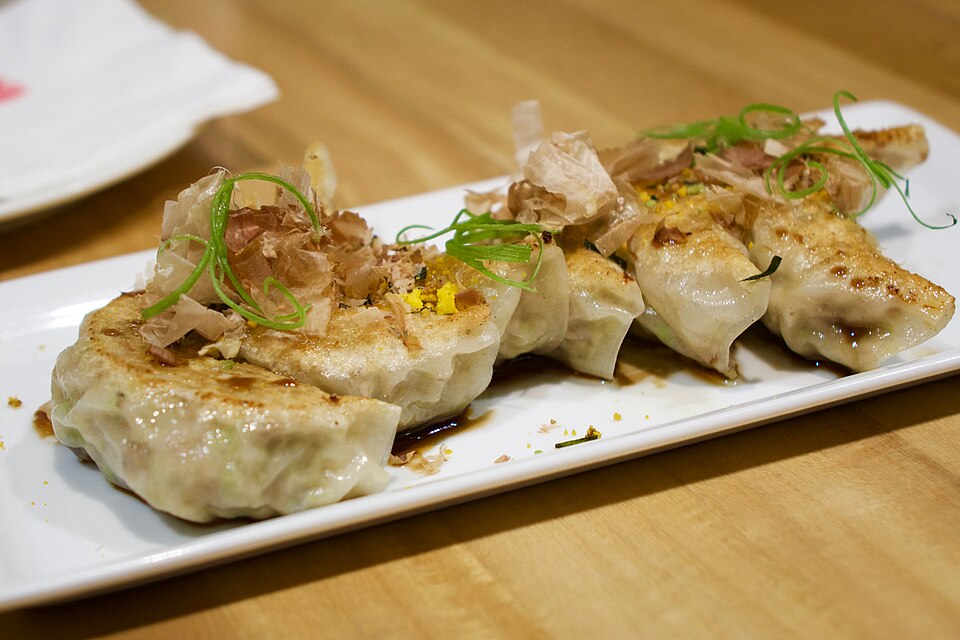
Gyoza are pan-fried dumplings with crisp bottoms and juicy pork and cabbage fillings that blend savory, garlicky flavor with soft steamed tops. Inspired by Chinese jiaozi, they became a Japanese staple post-World War II and are now a side dish favorite at ramen shops and izakayas. They’re often served with a soy and vinegar dipping sauce that cuts through the richness. Boiled or deep-fried versions also exist, though yaki-gyoza (pan-fried) remains most beloved.
- Region: Utsunomiya in Tochigi Prefecture is known as the “gyoza capital”
- Dietary notes: Contains wheat, pork, garlic; vegetarian versions are available but less common
- Key ingredients: Gyoza wrappers, ground pork, napa cabbage, garlic, ginger, soy sauce, sesame oil
- Usual cost: ¥300–¥600 for 5–6 pieces
Shabu Shabu
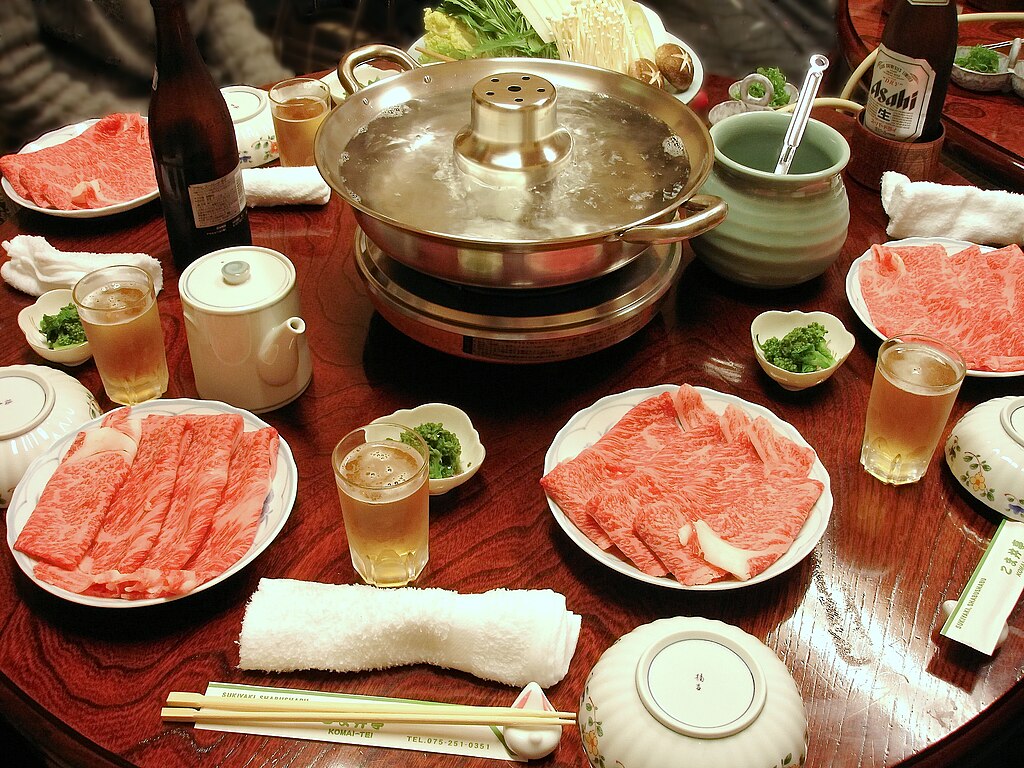
Shabu Shabu is a hot pot experience where diners swish thinly sliced beef or pork through simmering broth, cooking each piece to their preferred doneness. The name comes from the sound of the meat swishing in the pot. Vegetables, tofu, and mushrooms join the pot, and everything is dipped into citrusy ponzu or creamy sesame sauce before eating. It’s a social and interactive dining style, often shared with family or friends during colder months.
- Region: Kyoto origins, now popular nationwide
- Dietary notes: Includes meat and dipping sauces with soy; vegetarian versions possible with vegetable broth and tofu
- Key ingredients: Thin beef or pork slices, napa cabbage, enoki mushrooms, tofu, konjac noodles, ponzu sauce, goma (sesame) sauce
- Usual cost: ¥2,000–¥4,000 per person
Japanese Sweets (Wagashi)
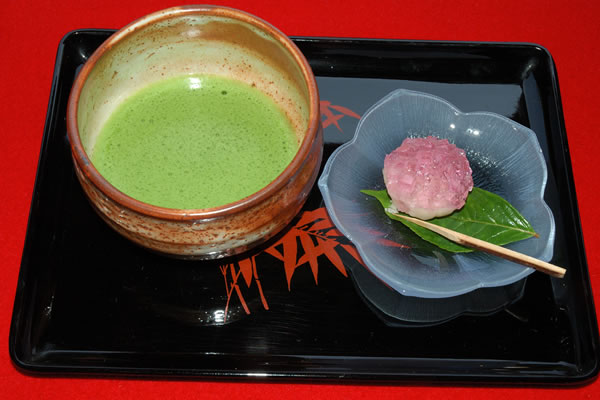
Wagashi are traditional Japanese confections enjoyed during tea ceremonies or as seasonal gifts. These delicately shaped sweets reflect nature and the calendar, made from ingredients like sweet red bean paste, rice flour, and agar. Popular varieties include daifuku, mochi, yokan, and nerikiri, each with a unique texture and appearance. They’re especially popular during cherry blossom and autumn foliage seasons.
- Region: Kyoto and Kanazawa are particularly renowned for wagashi craftsmanship
- Dietary notes: Most are vegetarian, many are gluten free, check for gelatin or added dairy in modern versions
- Key ingredients: Mochiko (rice flour), azuki beans, sugar, kanten (agar), chestnut, matcha, sesame
- Usual cost: ¥300–¥800 per piece, gift boxes from ¥1 500
To finish with dessert, let’s talk about traditional Japanese sweets. Known as wagashi, there are several popular types, including: manju, a small cake of sweet red bean paste covered in steamed flour; daifuku (sometimes called mochi) a rice cake with a sweet filling; and anmitsu, chilled jelly served with fruit and red bean paste. Usually paired with tea, Higashiya Ginza is a not-miss tearoom for anyone with a sweet tooth.
Japan has a wide variety of foods to try — and often with variations between regions and even stores. Standing tall as the food capital of the world, Tokyo is the best place to get Japanese cuisine that is not only authentic, but extraordinary. So, follow our Japan Food Guide in Tokyo, and as they say in Japan before a meal, ittadakimasu!

